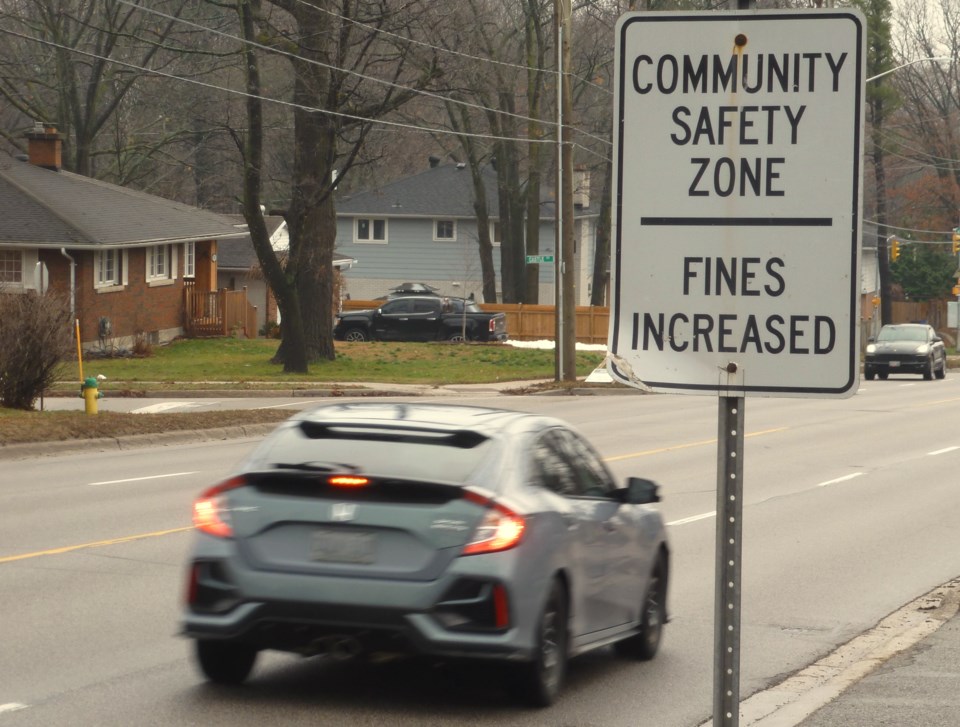If you are a speeder, you might want to put a little extra cash in your wallet. Just in case.
A long-awaited traffic calming policy report was presented to Midland council at a recent committee of the whole meeting, exploring various options in dealing with the challenges faced by residents, commuters, and pedestrians who find some of the town’s busiest streets tough to travel.
Since 2016, the traffic calming report has undergone many changes as council, town staff, and the public weighed in on its revisions.
Traffic calming is the means for municipalities to reduce speed, traffic, and ultimately complaints while increasing safety and efficiency along collector and local roads, especially in residential areas.
Andy Campbell, executive director of infrastructure and environment, explained what was at the heart of the need for traffic calming.
“In most cases, it’s ‘how do we change the behaviour of the driver?’” asked Campbell.
“We just heard from a resident on Fourth Street where the town has done (the most) traffic calming,” said Campbell of a resident deputation made moments before, “and they still have challenges and complaints.”
Public input requested for this version of the draft traffic calming policy sought to change the scoring system which looked at the qualifications of whether a particular street could be considered for the policy or not. Under the new scorecard, collector roads were included, collisions and vulnerable road user perspectives were simplified, and speed and volume were made more straightforward.
However, some streets still did not qualify for the policy under the new system. Both Bayview Drive and Christine Drive failed pre-screening due to low volume, and both Fifth Street and Victoria Street did not meet the low-point threshold for consideration. Additionally, both Midland Point Road and the section of Fourth Street between Yonge Street to Hugel Avenue did pass the pre-screening but failed on the point threshold.
Options provided in the report include costly and obstructive measures such as speed bumps, raised intersections, curb extensions, and roundabouts. More passive options for a cheaper cost included education, various signs, and road paint.
“We just painted a crosswalk in pretty colours which was over $10,000, that has to be done all the time,” said Campbell. “Today, we have $5,000 in our traffic calming budget that we spent; we’re proposing over $70,000 in next year’s budget. But that’s not for debate tonight, that’s something you’ll debate when you see the budget.”
Traffic calming has been a talking point between Midland councillors for some time, and one possible solution resonated within their ranks: community safety zones.
Coun. Bill Gordon spoke to the enforcement angle of reducing speeding.
“If you want to make the bite from getting pulled over from speeding hurt a little more in the wallet, then you raise the impact of that speeding ticket. That’s a pretty cheap implementation for us. It’s some cheap metal signs and we declare those sections of road -- not the entire roadway -- as community safety zones,” said Gordon.
Coun. Jim Downer hoped to implement community safety zones “the sooner the better”, while Coun. Cher Cunningham noted that many roads in Ward 3, such as Sunnyside and Midland Point Road, were in need of sidewalks which she said cannot be afforded.
“Enforcement is a huge part of it,” said Mitch Sobil, manager of engineering. “If you don't have the enforcement to go along with the community safety zone signage, you have no bite to the bark.”
Within the report, staff recommended implementing transportation analytic company Streetlight Data software as a means of passively collecting big data, such as cellular phones and GPS, to isolate and analyze which areas were most in need of traffic calming measures.
Sobil explained that one costed option for Midland would “allow us to get the data breakdown to see when is the time of day when the speeders are occurring, so we could possibly target enforcement a little better, to say maybe the hours of 8 a.m. to 10 a.m. In that morning rush, the speeding tends to be a little higher in these locations. And we can target OPP possibly to those.
“Probably the biggest thing from staff’s benefit is it allows us to do our analysis much faster,” Sobil added.
Mayor Stewart Strathearn called the report a starting point, but cautioned against overuse of community safety zones.
“I do hope we don’t get into putting them everywhere,” said Strathearn, “because familiarity breeds contempt.”
Council carried the motion to adopt and have staff implement the revised traffic calming policy and guide. Campbell noted that further public engagement would be forthcoming as some areas in the policy are given a deeper examination.
Later in the meeting, Coun. Cunningham introduced a notice of motion for the next council meeting that a community safety zone be implemented on Midland Point Road at or around the Portage Park bus stop within the 2021 budget cycle, and that staff come back to council with recommendations.
The revised traffic calming policy and guide report is available in full in the council agenda on the town of Midland website.
Council meetings are held on the first and third Wednesdays of each month, and can be viewed on Rogers TV cable channel 53, or through the livestream on the Rogers TV website. Archives of council meetings are available through Rogers TV and on the Town of Midland’s YouTube channel.
